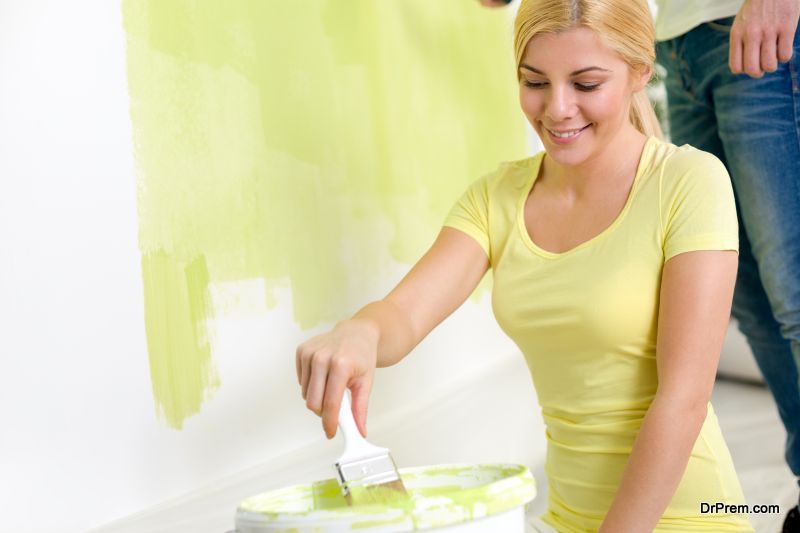A freshly painted home is marvelous to step into. Many people like the scent of fresh paint, and compare it to the smell of freshly cut grass. Fresh paint is however not as harmless as grass, as the paint has harmful chemicals called VOCs. These VOCs are ranked among the top environmental offenders and are responsible for releasing into the air approximately a whopping 50 billion kilograms of carbon compounds each year. You can never imagine that a fresh coat of paint could be so dangerous, to the environment, and to your health. There are low and zero VOC paints available which can substitute for VOC laden paint. Read on to find out more low VOC paint:
What are low and zero VOC paints?

Firstly, what are VOCs? VOCs are very unstable carbon compounds which vaporize into the air easily. After being released into the air, VOCs react with different elements to produce the gas ozone, which is the main cause of air pollution. Ozone causes many health issues such as respiratory problems, watery eyes, headaches, and nausea. Some VOCs have been related to liver damage and cancer. In the process of paint drying, VOCs are released into the indoor air, which then becomes toxic for the residents.
The VOCs are present in oil-based solvents added to the paint such as formaldehyde, white spirit, toluene, alcohols, acetates, ketones, and aromatic compounds.
So what is low VOC paint? Low and zero VOC paints have less VOCs or no VOCs at all, as they are water-based paints. This reduces the amount of gas produced by VOCs released into the air. You have to check various paints and select the one which has least VOCs. The paints which have no or zero VOCs are those which do not contain VOCs but might contain some other dangerous chemicals.
What are other alternatives to paint containing VOCs?

Apart from chemical laden paints chock full of VOCs, there are other alternative paints you could use to paint your home or car. Understanding the term Zero VOC paint is crucial to making the right choice of paint.
There are natural paints which comprise of natural materials such as lime, clay, chalk, and linseed oil. As these paints do not have any synthetic oils, they are therefore considered to be low and zero VOC paints. Though they are low in EPA regulated VOCs, they do contain unregulated VOCs from terpenes and citrus oils, which might sometimes aggravate allergies in people who are sensitive to certain chemicals. Calcium, which is used in natural yellow paint, is quite toxic. So before buying natural paints, do read the ingredients.
How about making your own paint?

When you’re looking for answers to what is low VOC paint, you can opt to make your own paint. If you do that, you’re in control of using the ingredients you want, and thus make a comparatively harmless paint than the store-bought paint – over which you have no control. Eco- friendly and health-friendly paint can be made from ingredients like milk, flour, eggs, chalk, and linseed oil. You can check online for milk-based paint which requires milk proteins.
Pros of low VOC paints
 Most natural, eco-friendly low and zero VOC paints perform just as well as regular paints. There might be a few hiccups, however. For example, the natural paint may not thin out as well, making it difficult for you to apply them. They may take a longer time to dry as well (as they do not contain VOCs!), and you could have to wait a long time between applying coats. The color choice is a little limited, as darker pigments require VOCs, so eco-friendly paints with low or zero VOCs usually are available in lighter shades of color.
Most natural, eco-friendly low and zero VOC paints perform just as well as regular paints. There might be a few hiccups, however. For example, the natural paint may not thin out as well, making it difficult for you to apply them. They may take a longer time to dry as well (as they do not contain VOCs!), and you could have to wait a long time between applying coats. The color choice is a little limited, as darker pigments require VOCs, so eco-friendly paints with low or zero VOCs usually are available in lighter shades of color.
Tip: When you are looking at paints to buy, apart from checking from VOCs, check for the percentage of solids as well. If the paint contains 30% solids, you would save money as you need to apply only two coats instead of three. This information can be found on Technical Data Sheet or the label.
Before buying paint, take the time to read and research about different paint options available to you. Buy paints labeled ‘non-toxic’ and check that they do not have any extra additives or solvents, and have less than or equal to 5g/L of VOCs.


